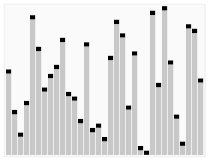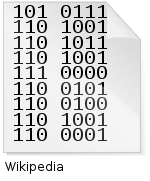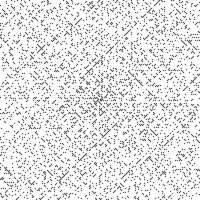TOPICS IN DISCRETE MATHEMATICS
Theoretical computer science
Theoretical computer science includes areas of discrete mathematics relevant to computing. It draws heavily on graph theory and mathematical logic. Included within theoretical computer science is the study of algorithms for computing mathematical results. Computabilitystudies what can be computed in principle, and has close ties to logic, while complexity studies the time, space, and other resources taken by computations. Automata theory and formal language theory are closely related to computability. Petri nets and process algebras are used to model computer systems, and methods from discrete mathematics are used in analyzing VLSI electronic circuits. Computational geometryapplies algorithms to geometrical problems, while computer image analysis applies them to representations of images. Theoretical computer science also includes the study of various continuous computational topics.
Information theory
Information theory involves the quantification of information. Closely related is coding theory which is used to design efficient and reliable data transmission and storage methods. Information theory also includes continuous topics such as: analog signals, analog coding, analog encryption.
Logic
Logic is the study of the principles of valid reasoning and inference, as well as of consistency, soundness, and completeness. For example, in most systems of logic (but not in intuitionistic logic) Peirce's law (((P→Q)→P)→P) is a theorem. For classical logic, it can be easily verified with a truth table. The study of mathematical proof is particularly important in logic, and has applications to automated theorem proving and formal verification of software.
Logical formulas are discrete structures, as are proofs, which form finite treesor, more generally, directed acyclic graph structures (with each inference step combining one or more premise branches to give a single conclusion). The truth values of logical formulas usually form a finite set, generally restricted to two values: true and false, but logic can also be continuous-valued, e.g., fuzzy logic. Concepts such as infinite proof trees or infinite derivation trees have also been studied, e.g. infinitary logic.
Set theory
Set theory is the branch of mathematics that studies sets, which are collections of objects, such as {blue, white, red} or the (infinite) set of all prime numbers. Partially ordered setsand sets with other relations have applications in several areas.
In discrete mathematics, countable sets (including finite sets) are the main focus. The beginning of set theory as a branch of mathematics is usually marked by Georg Cantor's work distinguishing between different kinds of infinite set, motivated by the study of trigonometric series, and further development of the theory of infinite sets is outside the scope of discrete mathematics. Indeed, contemporary work in descriptive set theory makes extensive use of traditional continuous mathematics.
Combinatorics
Combinatorics studies the way in which discrete structures can be combined or arranged. Enumerative combinatorics concentrates on counting the number of certain combinatorial objects - e.g. the twelvefold way provides a unified framework for counting permutations, combinations and partitions. Analytic combinatorics concerns the enumeration (i.e., determining the number) of combinatorial structures using tools from complex analysis and probability theory. In contrast with enumerative combinatorics which uses explicit combinatorial formulae and generating functions to describe the results, analytic combinatorics aims at obtaining asymptotic formulae. Design theory is a study of combinatorial designs, which are collections of subsets with certain intersection properties. Partition theory studies various enumeration and asymptotic problems related to integer partitions, and is closely related to q-series, special functions and orthogonal polynomials. Originally a part of number theory and analysis, partition theory is now considered a part of combinatorics or an independent field. Order theory is the study of partially ordered sets, both finite and infinite.
Graph theory
Graph theory, the study of graphs and networks, is often considered part of combinatorics, but has grown large enough and distinct enough, with its own kind of problems, to be regarded as a subject in its own right. Graphs are one of the prime objects of study in discrete mathematics. They are among the most ubiquitous models of both natural and human-made structures. They can model many types of relations and process dynamics in physical, biological and social systems. In computer science, they can represent networks of communication, data organization, computational devices, the flow of computation, etc. In mathematics, they are useful in geometry and certain parts of topology, e.g. knot theory. Algebraic graph theory has close links with group theory. There are also continuous graphs, however for the most part research in graph theory falls within the domain of discrete mathematics.
Probability
Discrete probability theory deals with events that occur in countable sample spaces. For example, count observations such as the numbers of birds in flocks comprise only natural number values {0, 1, 2, ...}. On the other hand, continuous observations such as the weights of birds comprise real number values and would typically be modeled by a continuous probability distribution such as the normal. Discrete probability distributions can be used to approximate continuous ones and vice versa. For highly constrained situations such as throwing dice or experiments with decks of cards, calculating the probability of events is basically enumerative combinatorics.
Number theory
Number theory is concerned with the properties of numbers in general, particularly integers. It has applications to cryptography and cryptanalysis, particularly with regard to modular arithmetic, diophantine equations, linear and quadratic congruences, prime numbers and primality testing. Other discrete aspects of number theory include geometry of numbers. In analytic number theory, techniques from continuous mathematics are also used. Topics that go beyond discrete objects include transcendental numbers, diophantine approximation, p-adic analysisand function fields.
Algebra
Algebraic structures occur as both discrete examples and continuous examples. Discrete algebras include: boolean algebra used in logic gatesand programming; relational algebra used in databases; discrete and finite versions of groups, rings and fields are important in algebraic coding theory; discrete semigroups and monoids appear in the theory of formal languages.
Calculus of finite differences, discrete calculus or discrete analysis
A function defined on an interval of the integers is usually called a sequence. A sequence could be a finite sequence from a data source or an infinite sequence from a discrete dynamical system. Such a discrete function could be defined explicitly by a list (if its domain is finite), or by a formula for its general term, or it could be given implicitly by a recurrence relation or difference equation. Difference equations are similar to a differential equations, but replace differentiation by taking the difference between adjacent terms; they can be used to approximate differential equations or (more often) studied in their own right. Many questions and methods concerning differential equations have counterparts for difference equations. For instance, where there are integral transforms in harmonic analysis for studying continuous functions or analogue signals, there are discrete transformsfor discrete functions or digital signals. As well as the discrete metric there are more general discrete or finite metric spaces and finite topological spaces.
Geometry
Discrete geometry and combinatorial geometry are about combinatorial properties of discrete collections of geometrical objects. A long-standing topic in discrete geometry is tiling of the plane. Computational geometry applies algorithms to geometrical problems.
Topology
Although topology is the field of mathematics that formalizes and generalizes the intuitive notion of "continuous deformation" of objects, it gives rise to many discrete topics; this can be attributed in part to the focus on topological invariants, which themselves usually take discrete values. See combinatorial topology, topological graph theory, topological combinatorics, computational topology, discrete topological space, finite topological space, topology (chemistry).
Operations research
Operations research provides techniques for solving practical problems in engineering, business, and other fields — problems such as allocating resources to maximize profit, or scheduling project activities to minimize risk. Operations research techniques include linear programming and other areas of optimization, queuing theory, scheduling theory, network theory. Operations research also includes continuous topics such as continuous-time Markov process, continuous-time martingales, process optimization, and continuous and hybrid control theory.
Game theory, decision theory, ut
| Cooperate | Defect | |
| Cooperate | −1, −1 | −10, 0 |
| Defect | 0, −10 | −5, −5 |
| Payoff matrix for the Prisoner's dilemma, a common example in game theory. One player chooses a row, the other a column; the resulting pair gives their payoffs | ||
Decision theory is concerned with identifying the values, uncertainties and other issues relevant in a given decision, its rationality, and the resulting optimal decision.
Utility theory is about measures of the relative economic satisfaction from, or desirability of, consumption of various goods and services.
Game theory deals with situations where success depends on the choices of others, which makes choosing the best course of action more complex. There are even continuous games, see differential game. Topics include auction theory and fair division.
Discretization
Discretization concerns the process of transferring continuous models and equations into discrete counterparts, often for the purposes of making calculations easier by using approximations. Numerical analysis provides an important example.
Discrete analogues of continuous mathematics
There are many concepts in continuous mathematics which have discrete versions, such as discrete calculus, discrete probability distributions, discrete Fourier transforms, discrete geometry, discrete logarithms, discrete differential geometry, discrete exterior calculus, discrete Morse theory, difference equations, discrete dynamical systems, and discrete vector measures.
In applied mathematics, discrete modelling is the discrete analogue of continuous modelling. In discrete modelling, discrete formulae are fit to data. A common method in this form of modelling is to use recurrence relation.
In algebraic geometry, the concept of a curve can be extended to discrete geometries by taking the spectra of polynomial rings over finite fields to be models of the affine spacesover that field, and letting subvarieties or spectra of other rings provide the curves that lie in that space. Although the space in which the curves appear has a finite number of points, the curves are not so much sets of points as analogues of curves in continuous settings. For example, every point of the form for a field can be studied either as , a point, or as the spectrum of the local ring at (x-c), a point together with a neighborhood around it. Algebraic varieties also have a well-defined notion of tangent space called the Zariski tangent space, making many features of calculus applicable even in finite settings.






![V(x-c)\subset \operatorname {Spec} K[x]=\mathbb {A} ^{1}](https://wikimedia.org/api/rest_v1/media/math/render/svg/147df15a1780a002602cd26438adbec315699e2b)

![\operatorname {Spec} K[x]/(x-c)\cong \operatorname {Spec} K](https://wikimedia.org/api/rest_v1/media/math/render/svg/80cc3220b7c86e6d0862f1bcf3fbac3ffc0191a7)
![\operatorname {Spec} K[x]_{(x-c)}](https://wikimedia.org/api/rest_v1/media/math/render/svg/76e6e66e203e1805ec5b90fa25d9f0c817f28dd7)